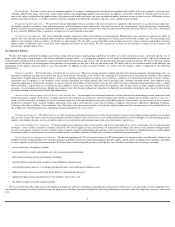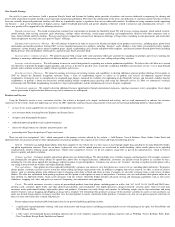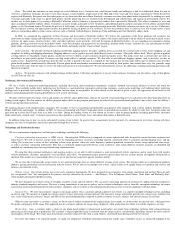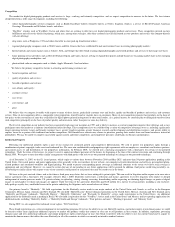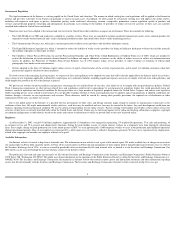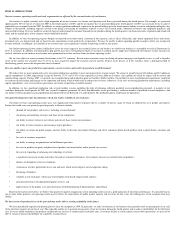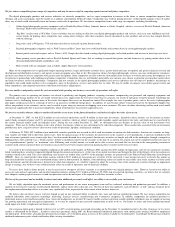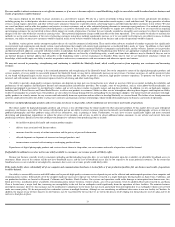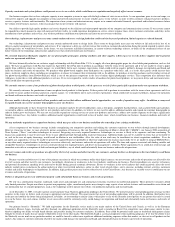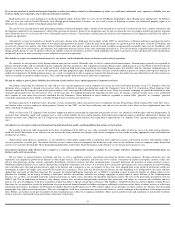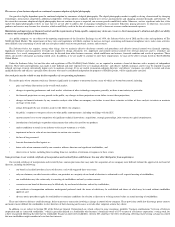Shutterfly 2008 Annual Report Download - page 16
Download and view the complete annual report
Please find page 16 of the 2008 Shutterfly annual report below. You can navigate through the pages in the report by either clicking on the pages listed below, or by using the keyword search tool below to find specific information within the annual report.
We have a limited public company operating history, which makes it difficult to evaluate our business and prospects for the future.
We became a public company in September 2006, and we have only a limited public operating history on which investors can base an evaluation of our business and future
prospects. We face many risks, uncertainties, expenses and difficulties. To address these risks and uncertainties, we must do the following:
We may be unable to accomplish one or more of these requirements, which could cause our business to suffer. Accomplishing one or more of these requirements might be very
expensive, which could harm our financial results.
If we are not able to reliably meet our data storage and management requirements, customer satisfaction and our reputation could be harmed.
As a part of our current business model, we offer our customers free unlimited online storage and sharing of photographs and, as a result, must store and manage multiple petabytes
of data. This results in immense system requirements and substantial ongoing technological challenges, both of which are expected to continue to increase over time. If we are not able
to reliably meet these data storage and management requirements, we could have disruptions in services which could impair customer satisfaction and our reputation and lead to
reduced net revenues and increased expenses. Moreover, if the cost of meeting these data storage and management requirements exceeds our expectations, our results of operations
would be harmed.
Our data storage system could suffer damage or interruption from human error, fire, flood, power loss, telecommunications failure, break-
ins, terrorist attacks, acts of war and
similar events. In addition, our primary storage facilities are located near a major fault line, increasing our susceptibility to the risk that an earthquake could significantly harm our data
storage system. If we experience disruption to our redundant systems located at our data storage center, such disruption could result in the deletion or corruption of customer stored
images. For example, in 2007, we experienced a loss of a small number of customer images due to an isolated server failure.
Interruptions to our website, information technology systems, print production processes or customer service operations could damage our reputation and brand and substantially
harm our business and results of operations.
The satisfactory performance, reliability and availability of our website, information technology systems, printing production processes and customer service operations are critical
to our reputation, and our ability to attract and retain customers and maintain adequate customer satisfaction. We currently conduct periodic site maintenance several times a quarter
that sometimes requires us to take the website down. The scheduled down times are planned at non-
peak hours, typically at midnight. Any interruptions that result in the unavailability
of our website or reduced order fulfillment performance or customer service could result in negative publicity, damage our reputation and brand and cause our business and results of
operations to suffer. This risk is heightened in the fourth quarter, as we experience significantly increased traffic to our website during the holiday season. Any interruption that occurs
during such time would have a disproportionately negative impact than if it occurred during a different quarter.
We depend in part on third parties to implement and maintain certain aspects of our communications and printing systems. Therefore many of the causes of system interruptions or
interruptions in the production process may be outside of our control. As a result, we may not be able to remedy such interruptions in a timely manner, or at all. Our business
interruption insurance policies do not address all potential causes of business interruptions that we may experience, and any proceeds we may receive from these policies in the event of
a business interruption may not fully compensate us for the revenues we may lose.
We may have difficulty managing our growth and expanding our operations successfully.
We have grown from 275 employees as of December 31, 2006 to 431 employees as of December 31, 2007. We have website operations, offices and customer support centers in
Redwood City, California and Mesa, Arizona, and production facilities in Hayward, California and Charlotte, North Carolina. Our growth has placed, and will continue to place, a
strain on our administrative and operational infrastructure. Our ability to manage our operations and growth will require us to continue to refine our operational, financial and
management controls, human resource policies and reporting systems.
If we are unable to manage future expansion, we may not be able to implement improvements to our controls, policies and systems in an efficient or timely manner and may
discover deficiencies in existing systems and controls. Our ability to provide a high-
quality customer experience could be compromised, which would damage our reputation and brand
and substantially harm our business and results of operations.
During 2008, we plan to implement a new enterprise resource planning system (“ERP”)
as part of our strategy to provide scale in our operations. These projects are expensive,
complex, and subject to delays. If we are not able to effectively manage the deployment of this new ERP system, our results of operations, or our ability to provide timely financial
reporting information may be harmed.
Competitive pricing pressures, particularly with respect to 4×6 print pricing and shipping, may harm our business and results of operations.
Demand for our products and services is sensitive to price. Many external factors, including our production and personnel costs and our competitors’
pricing and marketing
strategies, can significantly impact our pricing strategies. If we fail to meet our customers’
price expectations, we could lose customers, which would harm our business and results of
operations.
Changes in our pricing strategies have had, and may continue to have, a significant impact on our net revenues and net income. From time to time, we have made changes to our
pricing structure for 4×6 prints in order to remain competitive. In December, 2007, one of our competitors lowered their list prices on 4×6 prints from $0.12 to $0.09. To date, we have
not made any additional changes to the price of our 4×6 prints as a result of this price cut. However, a drop in our 4×6 prices, without a corresponding increase in volume, or decreases
in volume as a result of competitive pressures would negatively impact our net revenues and could adversely affect our gross margins and overall profitibility.
We generate a significant portion of our net revenues from the fees we collect from shipping our products. For example, these fees represented approximately 19%, 20% and 19%
of our net revenues in 2007, 2006 and 2005 respectively. We offer discounted or free shipping, with a minimum purchase requirement, during promotional periods to attract and retain
customers. If free shipping offers extend beyond a limited number of occasions, are not based upon a minimum purchase requirement or become commonplace, our net revenues and
results of operations would be negatively impacted. In addition, Shutterfly occasionally offers free or discounted products and services to attract and retain customers. In the future, if
•
maintain and increase the size of our customer base;
•
maintain and enhance our brand;
•
maintain and grow our website and customer operations;
•
enhance and expand our products and services;
•
successfully execute our business and marketing strategy;
•
continue to develop and upgrade our technology and information processing systems;
•
continue to enhance our service to meet the needs of a changing market;
•
provide superior customer service;
•
respond to competitive developments; and
•
attract, integrate, retain and motivate qualified personnel.


